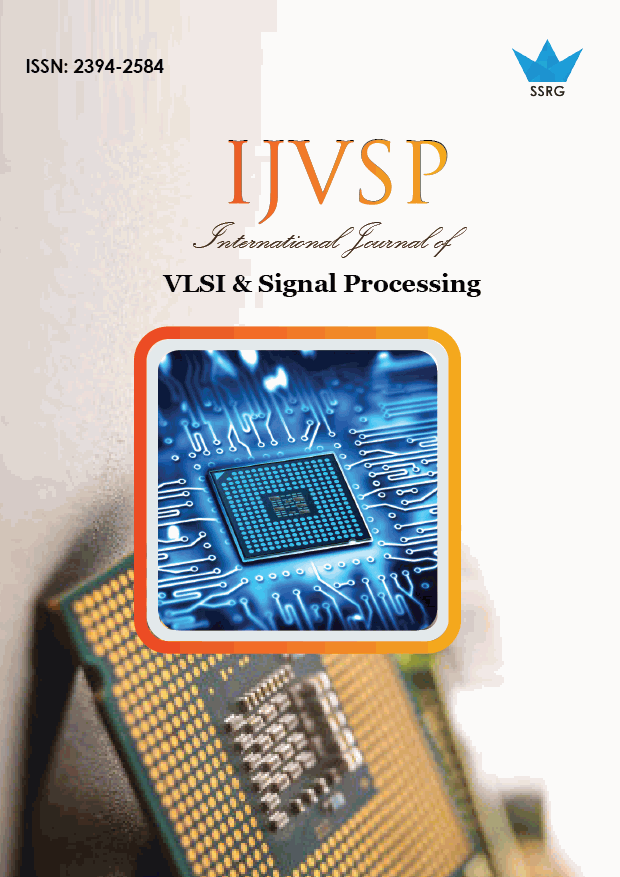D flip flops for Linear Response Shift Register in CMOS technology

| International Journal of VLSI & Signal Processing |
| © 2017 by SSRG - IJVSP Journal |
| Volume 4 Issue 3 |
| Year of Publication : 2017 |
| Authors : J.Hinay shelly and B.Craige Shreen |
How to Cite?
J.Hinay shelly and B.Craige Shreen, "D flip flops for Linear Response Shift Register in CMOS technology," SSRG International Journal of VLSI & Signal Processing, vol. 4, no. 3, pp. 16-20, 2017. Crossref, https://doi.org/10.14445/23942584/IJVSP-V4I5P104
Abstract:
The incorporated chip manufacturing technology has completed an assessment by decrease the size of a chip and improving its better performance. Reduction of chip announces harms comprising heat degeneracy and power depletion. As chip manufacturing technology is abruptly on the inception of most importantestimation, which contracts chip in dimension and performance, Linear Feedback Shift Register is executed in design level which advances the low power consumption chip, using current CMOS, submicrometer designimplements. Hencethis counter can be aninnovative pacesetter in cryptography and is also valuable to the variability of other applications. Dualisticnumber system using LFSR is offered to decrease these complications. The proposed system strategy gives low power design, by qualifiedexploration of a number of LFSR planning in expressions of hardware application, CMOS design and power consumption.
Keywords:
Linear Feedback Shift Register, Binary numeral system, dynamic logic.
References:
[1] Neil Weste, Harris, Benerjee: CMOS VLSI Design: A Circuits and Systems Perspective, 3/e, (2006).
[2] J. Saxena, K. Butler, and L. Whetsel, “An analysis of power reduction techniques in scan testing,” in Proc. Int. Test Conf., 2001, pp. 670–677.
[3] Etienne Sicard,SoniaDelmasBendhia: Basic CMOS Cell Design, Mc Graw Hill Publishers (2005).
[4] P. Girard, “Survey of low-power testing of VLSI circuits,” IEEE Des. Test Comput vol. 19, no. 3, pp. 80–90, May/Jun. 2002.
[5] Sung-MO Kang,YusufLeblebici: CMOS Digital Integrated Circuits-Analysis and Design (2003).
[6] John P. Uyemura, “Chip design for submicron VLSI: CMOS layout and Simulation”, Cengage Learning, 2006.
[7] John F Wakerly.K: Digital Design-Principles and practices, Prentice Hall Publishers (2005).
[8] R. S. Katti, X. Ruan, and H. Khattri, “Multiple-output lowpower linear feedback shift register design,” IEEE Tran Circuits Syst I, Reg. Papers, vol. 53, no. 7, pp. 1487–1495, Jul. 2006.
[9] Neil Weste, Kamran:Principles& Applications of CMOS Logic: Addison-Wesley Publishers (1993).
[10] James L. Massey: On the Shift register Synthesis & BCH Decoding: IEEE Transactions. Information Theory, Vol IT-15, n.1, pp.122-127,(1969).
[11] Arshdeep Singh, Oscar Servin, Edward Lee, LutfiBustami: 4017 CMOS LED Chaser Counter, A project (2004).
[12] Timothy Brian Brock: Linear Feedback Shift Registers and Cyclic Codes in SAGE: Rose-Hulman Undergraduate Mathematics Journal, volume 7, number 2, (2006).
[13] KrishnenduChakrabarty, Brian. Murray, VikramIyengar: Deterministic Built-in Test Pattern Generation for High- Performance Circuits Using Twisted- Ring Counters: IEEE Journals on VLSI Sytems, Vol 8,Issue 5,pp.633-636, (2000).
[14] Kazuo Yano: Top down pass-Transistor Logic Design,” IEEE Journal of solid-state circuits, vol-31, No-6, (1996).
[15] R.Jacob Baker (2010). CMOS: Circuit Design, Layout, and Simulation (3rd ed.). Wiley-IEEE. ISBN 9780470881323, chapter 14, "Dynamic logic gates".
[16] Kazuo Yano: A 3.8 CMOS 16 * 16 –b multiplier using complementary pass-transistor Logic: IEEE Journal of solid-state circuits, vol-25, No-2,(1990).
[17] Sung-Mo Kang; Yusuf Leblebici (2003) CMOS digital integrated circuits: analysis and design (3rd ed.), McGraw- Hill ISBN 9780072460537, chapter 9, "Dynamic logic circuits".
[18] Zhongchuan Yu: An Investigation into the Security of Self-timed Circuits: LFSR design and Implementation, Thesis, Ch-5 (2003)
[19] Xilinx, Inc., “Efficient Shift Registers, LFSR Counters, and Long Pseudo-Random Sequence Generators”, pdf, date accessed: February 15, 2003, date written: October 11, 2003.
[20] SalendraGovindarajuluet. al.: Design of High Performance Dynamic CMOS Circuits in Deep Submicron Technology: International Journal of Engineering Science and Technology, Vol. 2(7), (2010).

 10.14445/23942584/IJVSP-V4I5P104
10.14445/23942584/IJVSP-V4I5P104